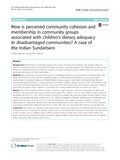| dc.contributor.author | Barman, Debjani | |
| dc.contributor.author | Vadrevu, Lalitha | |
| dc.coverage.spatial | India | en |
| dc.date.accessioned | 2017-04-06T10:42:03Z | |
| dc.date.available | 2017-04-06T10:42:03Z | |
| dc.date.issued | 2016-11-15 | |
| dc.identifier.citation | Barman, D. and Vadrevu, L., 2016. How is perceived community cohesion and membership in community groups associated with children’s dietary adequacy in disadvantaged communities? A case of the Indian Sundarbans. BMC Health Services Research, 16(7), p.73. | en |
| dc.identifier.issn | 1472-6963 | |
| dc.identifier.uri | https://opendocs.ids.ac.uk/opendocs/handle/20.500.12413/12935 | |
| dc.description.abstract | Background:
Membership in community groups and a sense of community cohesion may facilitate collective action in mobilizing resources towards better health outcomes. This paper explores the relationship of these factors, along with individual level socio-economic variables, to dietary adequacy among children below 6 years of age, a proximate determinant of child malnutrition.
Methods:
We conducted a cross-sectional survey in Patharpratima block of the Sundarbans in West Bengal, India, using a two-stage, 30 cluster random sampling design. In 1200 sampled households, we used a structured questionnaire to interview mothers of children below 6 years of age on their child’s nutritional intake. We also interviewed household heads to assess perceived community cohesion using a nine item scale, membership in any community self-help organization, and other socio-economic determinants. We used a logistic regression model to assess their association with a minimum acceptable diet among children between 6 months to 6 years.
Results:
Only 9.33 % children between 6 and 71 months of age received a minimum acceptable diet. With each increase in the perceived community cohesion score (scale 0-9), a child is 1.31 times more likely to have minimum acceptable diet (95 % CI 1.14, 1.50). The odds of minimum acceptable diet were also higher among children whose mothers had primary education (2.09, 95 % CI 1.03, 2.94) as compared to illiterate mothers and in households with surplus food resources (2.72, 95 % CI 1.32, 5.58) as compared to those without surplus or deficit. In contrast, registering at an Anganwadi (government early child development) centre (odds ratio 1.34 95 % CI 0.69, 2.60) and community membership (odds ratio 0.93, 95 % CI 0.59, 1.46) were not associated with minimum acceptable diet.
Conclusion:
The results are consistent with what is known about the importance of maternal education and access to food resources in ensuring that children have a minimum acceptable diet. Perceived community cohesion seems to play a positive role in children’s diets. Further research needs to clarify which community characteristics and services are the most relevant, how they can better support children’s diets, and how interventions can strengthen these community characteristics and services. | en |
| dc.language.iso | en | en |
| dc.publisher | BMC Health Services Research | en |
| dc.rights.uri | http://creativecommons.org/licenses/by/4.0/ | en |
| dc.subject | Children and Youth | en |
| dc.subject | Nutrition | en |
| dc.title | How is Perceived Community Cohesion and Membership in Community Groups Associated with Children’s Dietary Adequacy in Disadvantaged Communities? A Case of the Indian Sundarbans | en |
| dc.type | Article | en |
| dc.identifier.externaluri | https://bmchealthservres.biomedcentral.com/articles/10.1186/s12913-016-1862-z | en |
| dc.identifier.doi | 10.1186/s12913-016-1862-z | |
| dcterms.dateAccepted | 2016-11-15 | |
| rioxxterms.funder | Default funder | en |
| rioxxterms.identifier.project | Default project | en |
| rioxxterms.version | VoR | en |
| rioxxterms.versionofrecord | 10.1186/s12913-016-1862-z | en |
| rioxxterms.funder.project | c941507f-fd0b-4fc3-9822-4b2132f61a1d | en |


